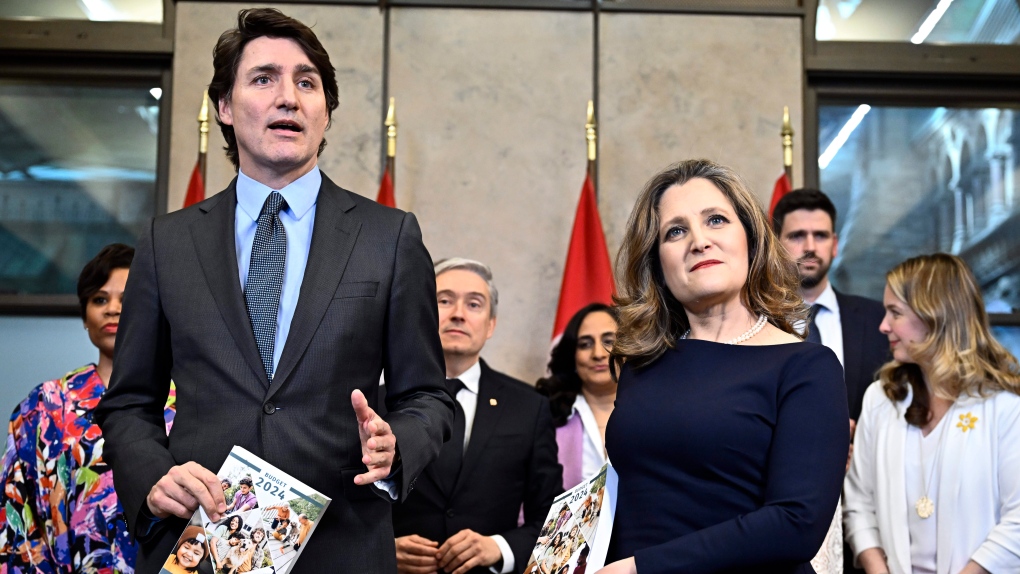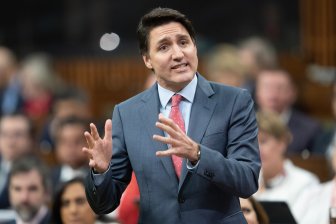News
Object shot down over Alaska was heading to Canada: sources
|
|
The unknown high-altitude object that the U.S. shot down near Alaska on Friday was heading into Canadian airspace, sources tell CTV News.
“The general area would be just off the very, very northeastern part of Alaska, right near the Alaska-Canada border,” White House National Security Council spokesperson John Kirby told reporters on Friday. “We’re calling this an object, because that’s the best description we have right now. We do not know who owns it.”
On Friday afternoon, U.S. officials announced that an F-22 fighter jet shot down the object off the coast of Alaska, not far from the Canadian border. The order to shoot it down came directly from U.S. President Joe Biden, just hours after Canadian Defence Minister Anita Anand met with her American counterpart at the Pentagon.
“Today at the Pentagon, United States Secretary of Defense Lloyd J. Austin III and I participated in a call with NORAD Commander, General Glen VanHerck regarding a high-altitude object detected over Alaska,” Anand said in a statement to CTV News. “The object did not fly into Canadian airspace. During this conversation, I conveyed Canada’s support for taking action to take down this object. NORAD deployed aircraft to track and monitor the object and provided important information to decision-makers – and the object was taken down earlier today by United States Northern Command.”
Roughly the size of a small car, the object was first detected Thursday night. A U.S. source told ABC News it was “cylindrical and silver-ish gray” and appeared to be floating. No details have emerged about its origins and purpose. Travelling at 40,000 feet (12,000 metres) and apparently unmanned and unable to manoeuvre, it was deemed a reasonable safety threat to civilian flights and shot down over the Arctic Ocean.
“Civilian aircraft operate at a variety of ranges, up to 40,000 to 45,000 feet (12,000 to 13,700 metres),” Pentagon press secretary and Air Force Brig. Gen. Pat Ryder told reporters on Friday. “So there was a reasonable concern that this could present a threat or a potential hazard to civilian air traffic.”
Recovery efforts are now ongoing at a reportedly frozen stretch of the Beaufort Sea.
“This afternoon, an object that violated American airspace was brought down,” Prime Minister Justin Trudeau said in a Tweet Friday evening. “I was briefed on the matter and supported the decision to take action.”
The incident follows the Feb. 4 downing of a suspected Chinese spy balloon that spent a week traversing Canada and the U.S.
“I think we shouldn’t be concerned,” CTV military analyst and retired Canadian Maj.-Gen. David Fraser told CTV News Channel. “The U.S. military and the Canadian military are going to be watching extremely vigilantly, looking for more of these things coming into our airspace and taking them out if they are a threat.”
Fellow retired Canadian Maj.-Gen. Denis Thompson expects U.S. officials to remain tight-lipped until they know more about the object.
“What is good to note is that it would have been picked up by Norad’s North Warning System, and that’s what would have triggered this decision making process that ended up in it being shot down,” Thompson told CTV News Channel.
A chain of 52 radar stations stretching 4,800 kilometres from Alaska to Labrador, the 1980s-era North Warning System acts as a “trip wire” for the continent’s northern approaches. It’s overseen by the North American Aerospace Defence Command, better known as Norad, which is a joint Canada-U.S. defence group.
“But wouldn’t it be ironic if this was a Russian balloon that they floated our way just to poke a stick in our eye?” Thompson speculated. “And that’s not unusual. Russia has constantly challenged Norad’s airspace with their strategic bombers, and they get turned around both by Canadian and American jets on a routine basis. So perhaps that’s all it is.”
With files from CTV News’ Parliamentary Bureau and the Associated Press





News
What is a halal mortgage? How interest-free home financing works in Canada – Global News
The federal government is looking at making Islamic home financing increasingly accessible to help more Canadians break into the housing market.
As part of the 2024 federal budget that was released last week, Ottawa said it is “exploring new measures to expand access to alternative financing products, like halal mortgages.”
Last month, the federal government started consulting financial services providers and communities to understand how policies can better support the needs of all Canadians seeking home ownership, according to the budget.
“Canada is home to a vibrant and growing market of alternative financing products, including halal mortgages, that enable Muslim Canadians, and other diverse communities, to further participate in the housing market,” the budget states.

Currently, none of Canada’s big six banks offer halal mortgages, which are an interest-free payment structure that follows Islamic principles.
However, some lenders in Canada have been offering halal mortgages for several years now.
“Halal mortgages are already offered to all Canadians by financial institutions,” Caroline Thériault, a spokesperson for the Department of Finance, said in an emailed statement to Global News Tuesday.
Thériault said halal mortgages are not government of Canada products.
“The government is simply looking at ways to help more Canadians become homeowners, while ensuring adequate consumer protections are in place.”
What is a halal mortgage?
A halal mortgage is a real estate financing method that complies with Islamic principles and teachings.
Under Sharia law, it is forbidden for Muslims to receive and pay interest, so a halal mortgage essentially takes interest out of the equation.
Instead, the mortgage is based on the principle of profit, said Mohamad Sawwaf, founder and CEO of Manzil, a Canadian financial institution that offers Sharia-compliant services.
Manzil has been offering halal mortgages that are both partnership- and profit-based since 2020.
“We look at this product as an innovation within the Canadian mortgage marketplace to allow for a segment of the population and the broader ethical community that may want to participate,” Sawwaf said in an interview with Global News Monday.
The end result of homeownership is the same, but the process and documentation are different compared with a regular mortgage, he said.
“Within the Islamic finance principles, you’re acquiring a real asset, it’s commodity-based, and then you are reselling it or partnering in that asset long-term, so that is the key difference here.”

Victor Tran, a mortgage and real estate expert at Ratesdot.ca and broker with True North Mortgage, said a halal mortgage is almost like a traditional mortgage where the lender and the homeowner have shared ownership of the property, but there are extra steps involved.
He said the difference is that “instead of charging interest to the homeowner, the contract is structured in a way where there’s a fee charged.”
Even though halal mortgages are interest-free, it doesn’t mean the lending happens at a zero per cent charge, Sawwaf said.
“It just means that you’re not part of a transaction where money is being lent and you have to pay more money back,” Sawwaf said.
“That is the principle of usury within Islam and other Abrahamic faiths that we’re trying to avoid.”
Usury, which is the lending of money at exorbitant interest rates, is also prohibited in Judaism and Christianity.
Types of halal mortgages
Halal mortgages in Canada fall under three different types of agreements, called Ijara, Murabaha and Musharaka, according to Rates.ca.
Ijara is like a rent-to-own agreement in which the inhabitant of the home starts as a renter and becomes the owner upon final loan payment, Tran said.
Under this type of financing, the home is purchased by a trust, which then leases it to the customer.
The Murabaha is a cost-plus financing structure in which an Islamic financial company becomes the owner of a home and sells it to their client for a price that includes a profit rate, which is benchmarked against the Bank of Canada’s overnight lending rate, Tran explained.
The client enters into a purchase agreement that specifies fixed monthly payments for the duration of the contract, which is usually up to 15 years.

Under the Musharaka arrangement, an Islamic financial company and its client become co-owners of a home, Tran said.
Throughout the mortgage term, which will follow the traditional mortgage term of up to 25 to 30 years, the financial company’s equity position decreases and the customer’s equity position increases proportionately as they pay out the owned balance.
At the end of the contract, the client will have 100 per cent home ownership and the company will have zero per cent, Sawwaf said.
Financial pros and cons of halal mortgages
From the financial standpoint, one of the main benefits of halal mortgages is that it introduces a long-term fixed mortgage rate, Sawwaf said.
For instance, under the Murabaha agreement, which follows the buy-and-sell structure, the mortgage can run up to 10 to 25 years.
Sawwaf said because the lender is sharing in the long-term risk, halal mortgages are “much more ethical and valuable at the end of the day” as opposed to having a debt-based system that is “not really good for society and its long-term social impact.”
However, the downside is that the costs of halal mortgages are higher because the lenders are not able to access low-cost capital, Sawwaf said.
“We’re hoping that the government signalling that they’re in support of halal mortgages with respect to potential legislation or policy changes, this could allow us to tap into institutional capital at the banks or other institutions,” he said.

Tran said because the costs and fees are a little bit higher for a halal mortgage than a traditional mortgage, it may not be a financially feasible option for many.
Among the measures that Ottawa is exploring are changes in the tax treatment of halal mortgages or a new regulatory sandbox for financial service providers.
Who can apply for a halal mortgage?
Anyone in Canada, Muslim or non-Muslim, can apply for a halal mortgage, which is currently offered by a few financial institutions.
“Everyone is allowed to have a halal mortgage no different than you can go to any restaurant and eat a shawarma with halal chicken in it,” Sawwaf said.
“We don’t care what your background is, your religion, your creed, even if you’re non-religious or an atheist.”
As for the down payment, most lenders in Canada require clients of halal financing to pay a minimum of 20 per cent of the market value, or purchase price, of the house.
Customers should also have a good credit history and sufficient income to meet the monthly payment obligation, the Canadian Halal Financial Corporation says.
More on Money
News
Amid concerns over 'collateral damage' Trudeau, Freeland defend capital gains tax change – CTV News


Facing pushback from physicians and businesspeople over the coming increase to the capital gains inclusion rate, Prime Minister Justin Trudeau and his deputy Chrystia Freeland are standing by their plan to target Canada’s highest earners.
In respective press conferences on Tuesday, both Trudeau and his finance minister defended their proposal to rake in $19.3 billion over the next five years by increasing the capital gains inclusion rate — the portion of capital gains on which tax is paid – for individuals with more than $250,000 in capital gains in a year.
This new revenue stream comes as the federal government plans to spend billions of dollars to increase Canada’s housing supply and enhance social programs, with the Liberals framing the new revenue as helping to offset those investments in a way that’s fair and doesn’t offload a larger deficit on younger generations.
“At a time when young people have started to give up on the dream of eventually ever being able to own a home, it was really important to rebalance the situation,” Trudeau said, speaking to reporters in Saskatchewan.
“I understand for some people this may cost more if they sell a cottage or a secondary residence. But, young people can’t buy their primary residences yet.”
What is the capital gains tax change?
As revealed in last week’s federal budget, the capital gains inclusion rate will increase from 50 per cent to 67 per cent, and will also apply to all capital gains realized by corporations and trusts.
That means that as of June 25, people with more than $250,000 in profit made on the sale of assets in a year will have to pay taxes on a larger portion of that money.
This incoming amendment to the Income Tax Act is expected to affect the wealthiest 0.13 per cent, and approximately 12 per cent of Canada’s corporations and Canadians with an average income of $1.42 million.
The inclusion rate for capital gains realized annually up to $250,000 is not changing, the existing capital gains exemption on primary residences will remain, and the lifetime exemption limit for small business shares, as well as farming and fishing properties is increasing.
What is the criticism?
While not the direct wealth tax or excess profit taxes some had anticipated – given Freeland’s dodging of questions about whether those were revenue routes the government was considering – since the budget was tabled, many Canadian business owners and entrepreneurs have raised concerns that the move could stunt innovation.
“At a time when our country is facing critically low productivity and business investment our political leaders are failing our country’s entrepreneurs,” wrote Shopify president Harley Finkelstein in a post on “X” last week.
On Tuesday, the Canadian Medical Association (CMA) also came out against the move, asking the Liberals to reconsider as the change will impact doctors’ retirement savings as most incorporate and operate their practice as a small business.
“It is completely unfair, late in the game taxation for those physicians who did follow the rules of the day and save for their retirement inside of our professional corporations,” CMA president Dr. Kathleen Ross said Tuesday.
PBO cautions ‘collateral damage’
It’s this kind of potential for “collateral damage” that Canada’s Parliamentary Budget Officer Yves Giroux voiced caution about in an interview on CTV News Channel’s Power Play on Friday, with host Mike Le Couteur.
Citing the sale of secondary residences such as cottages, or rental properties in the current housing market as examples of how Canadians could feel the impact of this tax change, Giroux said it’s not unusual for capital gains to be realized “well in excess of $250,000.”
“The moment you have a capital gain that’s higher than a quarter million, then you’re captured by that higher capital gains inclusion rate,” he said.
The PBO also cautioned that it’s difficult to determine based on the government’s current numbers, whether they will actually be able to generate the amount of revenue expected, but his office plans to assess that over the next couple of weeks.
What is the Liberals’ rationale?
In defending the capital gains reforms, both Trudeau and Freeland said the way the tax system currently works means a nurse, student, or carpenter could be paying income tax at a higher marginal rate than a multimillionaire who can use accountants to pay a lower tax rate.
“That’s not fair,” Freeland said, speaking in Toronto on Tuesday. “It is fair to ask those who are doing really well to contribute a little bit more.”
In the budget, the Liberals made a point of noting that this change will not impact 99.87 per cent of Canadians. Further, the 416-page document notes that in 2021, only around five per cent of Canadians under 30 had any capital gains at all.
And, next year, 28.5 million Canadians are not expected to have any capital gains income, while three million are expected to earn capital gains below the $250,000 annual threshold.
In an interview on CTV’s Question Period with Vassy Kapelos that aired Sunday, Conservative deputy leader Melissa Lantsman would not say whether her party would reverse the increase in the capital gains inclusion rate.
With files from CTV News’ Spencer Van Dyk
News
U.K. tabloids abuzz with Canadian's 'Loch Ness monster' photo – CBC.ca
U.K. tabloids and Loch Ness monster believers are abuzz after an expat Canadian couple photographed what some say could be the legendary water creature.
Parry Malm and Shannon Wiseman aren’t fully convinced themselves, but say they are coming around to the idea — particularly if it keeps their kids happy.
The family, which currently lives in the English city of Wimbledon, spent Easter vacation sightseeing in Scotland. To prepare for the trip, they loaded up on books about the Loch Ness monster.
While staying in a nearby cabin on a cold, blustery day in early April, the couple decided to visit a body of water where the sea creature is rumoured to live.
And that’s when they saw something moving through the waves.
“Its head was craning up above the water and it was slowly but gradually moving toward us,” Malm, who is originally from Coquitlam, B.C., said, quipping that it was “bigger than a Sasquatch but smaller than Ogopogo.”
A Canadian expat couple took a photo of something in the water of Loch Ness while on vacation in Scotland recently. They thought it might be a seal or an otter but their kids believed it could be the Loch Ness Monster, a claim that was picked up by U.K. tabloids. Parry Malm and Shannon Wiseman speak about the attention they’re receiving.
“So we obviously play it up. We have two little kids who are almost three and almost five,” he continued.
Wiseman, originally from Calgary, asked her sons, “Do you think it’s Nessie?” while taking a picture of the blurry object.
Little did they know that the image, and their names, would soon be plastered in U.K. tabloids as the first sighting of the Loch Ness monster of 2024.
Hundreds of years of history, but no official proof
Sightings of some sort of unexplained creature in Loch Ness date back to around 500 A.D., though modern sightings re generally traced to 1933, when a local newspaper reported a couple’s claims of seeing “an enormous animal rolling and plunging on the surface.”
Some have argued it’s a freshwater plesiosaur, though studies have found the creature went extinct before Loch Ness was formed. A DNA study of hundreds of water samples from Loch Ness found that if anything, sightings of the creature were most likely a giant eel.
Even a massive hunt in 2023 using state-of-the-art technology failed to turn up anything definitive.
Hundreds of ‘monster hunters’ are headed to the Scottish Highlands to take part in the biggest Loch Ness monster search in half a century. Andrew Chang explores why the event is a win for Scotland’s tourism industry in a post-pandemic world.
But the allure remains, with hundreds of tourists visiting the water every year in the hopes of seeing the creature — or at least coming away with a story to tell.
Among the believers is Gary Campbell and his daughter Page Daley, who have maintained a website since 1996 titled “The Official Loch Ness Monsters Sightings Register,” which aims to document all potential sightings of the creature, filtering out photos they are able to identify as waves, logs or other animals — as detailed on their page, “What’s not a sighting.”
Malm submitted their photo “just for a bit of a laugh” and, the next day, he says he got a reply telling him he had taken “the first confirmed sighting this year.”
The photo was posted to the website and picked up by U.K. tabloids including the Scottish Sun, Irish Star and the Daily Mirror.
‘We’re not tinfoil-hat-wearing people’
The couple is enjoying the attention and say their boys are fully on board with the notion they saw the Loch Ness monster, even if the adults aren’t quite convinced.
“My instinct says it might have been a seal but I am told that seals do not go in that lake,” Wiseman said.


“I mean, we’re not tinfoil-hat-wearing people,” Malm added. “There’s probably a perfectly logical explanation for what it was. Maybe species X lost its way home or something like that.”
But he says he’s not completely closed to the idea.
“There’s every possibility that there’s some sort of unexplained species that, from time to time, makes an appearance.”
For Wiseman, the fun comes in sharing an extraordinary memory with her kids.
“I want their childhood to be filled with the magic of the unbelievable,” she said. “And this is just one of those things: It is unbelievable, and they believe it so I believe it — and I am all in on that.”
Malm agrees: “What it sort of reaffirmed for me is there’s still things in the world that can surprise and delight you,” he said.
-



 Health10 hours ago
Health10 hours agoRemnants of bird flu virus found in pasteurized milk, FDA says
-
Art16 hours ago
Mayor's youth advisory council seeks submissions for art gala – SooToday
-



 Science24 hours ago
Science24 hours ago"Hi, It's Me": NASA's Voyager 1 Phones Home From 15 Billion Miles Away – NDTV
-



 Health14 hours ago
Health14 hours agoBird flu virus found in grocery milk as officials say supply still safe
-
News22 hours ago
Some Canadians will be digging out of 25+ cm of snow by Friday – The Weather Network
-
Media21 hours ago
Jon Stewart Slams the Media for Coverage of Trump Trial – The New York Times
-



 Investment15 hours ago
Investment15 hours agoTaxes should not wag the tail of the investment dog, but that’s what Trudeau wants
-
News15 hours ago
Peel police chief met Sri Lankan officer a court says ‘participated’ in torture – Global News









